The Liverpool Telescope, the world’s largest robotic observatory, began operations this week. The 2-metre telescope is operated from Liverpool John Moores University, but it’s actually located in the Canary Islands, and run remotely. The telescope is especially suited to watching astronomical objects which change over time, such as Gamma Ray Bursts, supernovae, asteroids and comets. 5% of its time has been donated to the National Schools’ Observatory program, allowing school children to perform astronomy research.
Sea Launch Heads Out
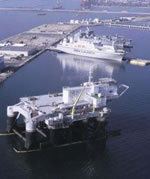
Image credit: Sea Launch
The Odyssey platform and Sea Launch Commander departed home port in California to make the journey down to the Earth’s equator in the Pacific Ocean. This time Sea Launch will loft the EchoStar IX/Telstar 13 broadcast satellite on board a Zenit-3SL rocket. The two-hour launch window is scheduled to begin on August 8 at 0331 GMT (11:31 pm EDT).
The Odyssey Launch Platform and the Sea Launch Commander have departed Sea Launch Home Port for the launch of the EchoStar IX/Telstar 13 satellite for EchoStar Communications Corporation and Loral Skynet. Liftoff is scheduled for August 7, in a two-hour launch window that will open at 8:31 pm PDT (3:31:00 GMT).
The Sea Launch vessels are sailing from Sea Launch Home Port, in the Port of Long Beach, Calif., to the launch site on the Equator at 154? West Longitude. Upon arrival, a 72-hour countdown will begin and the platform will be ballasted to launch depth. Over the course of the three-day countdown, the launch team will perform final tests on the rocket and spacecraft, and prepare for launch operations. The three-stage Zenit-3SL rocket will loft the 4,737 kg (10,443 lb) EchoStar IX/Telstar 13 satellite to a high perigee of 760 km in geosynchronous transfer orbit.
This is the first of several launch contracts Sea Launch will execute for Space Systems/Loral, the spacecraft manufacturer. The LS-1300-class satellite will be operational in its final position in geostationary orbit at 121? West Longitude. EchoStar?s Ku-band fixed satellite services (FSS) transponders are designed to enhance its U.S. DISH Network service. The spacecraft is also equipped with one of the first commercial Ka-band spot-beam payloads in the United States as well as a C-band payload.
In a unique satellite-sharing arrangement, EchoStar will own the Ku- and Ka-band payloads on this satellite. Loral Skynet, a subsidiary of Loral Space & Communications based in Bedminster, N.J., will own and operate the C-band capacity as Telstar 13. From its ideal orbital location and its 24 C-band transponders operating at 36 MHz, Telstar 13 will provide programmers with coverage of North America, including Alaska, Hawaii, Puerto Rico, Mexico and Central America.
Sea Launch Company, LLC, headquartered in Long Beach, Calif., is a world leader in providing heavy-lift commercial launch services. This multinational partnership offers the most direct and cost-effective route to geostationary orbit. With the advantage of a launch site on the Equator, the reliable Zenit-3SL rocket can lift a heavier spacecraft mass or provide longer life on orbit, offering best value plus schedule assurance. Sea Launch has a current backlog of 15 firm launch contracts. For additional information and live coverage of this mission, visit the Sea Launch website at: www.sea-launch.com
Note to editors: Sea Launch will carry a live satellite feed and streaming video of the entire mission on the day of launch. We will post transponder coordinates as well as additional information and high resolution images on a media site at: www.boeing.com/nosearch/sealaunch/
Original Source: Boeing News Release
What to Do With Hubble?
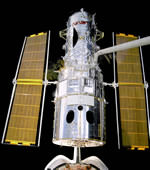
Image credit: NASA
The Hubble Space Telescope, one of the most important scientific instruments ever created, is entering the final chapter of its life, and NASA is trying to figure out what they should do with it. The Hubble Space Telescope was launched in 1990, and it’s expected to continue operations until 2010, when it’s replaced by the James Webb observatory which will launch in 2011. NASA has convened a special panel of experts to determine the best way to handle the transition.
The Hubble Space Telescope (HST) is one of the most important scientific facilities of NASA and indeed of the world. The HST has created enormous interest in astronomy and in space science, contributing in the process fundamental scientific discoveries related to the origins of the universe, the structure and evolution of the universe, and the exploration of the solar system. The scientific community has endorsed the James Webb Space Telescope as the next generation space telescope, the natural successor to the HST. It is a necessary task to consider exactly how and when to terminate the operation of this successful scientific experiment.
Currently, the end of Hubble operations is planned for 2010, and the launch of JWST is planned for late 2011. In principle, HST operations could be enhanced through continued servicing by the space shuttle. In fact, servicing may be essential to reach the 2010 target date. However, servicing missions by the shuttle are expensive and inherently dangerous.
NASA would like to assess the scientific impact of its current plan for effecting the transition from HST to JWST in the context of its overall space science program. In addition, NASA would like to determine if there are modifications to this plan that may better address key scientific issues within the constraints provided by the agency?s strategic plan and budget.
To this end NASA has chartered a panel of senior community members, with John Bahcall serving as chair, to review agency plans and to receive community input on the HST – JWST transition topic. The links below lead to the panel’s charter, membership roster, information about a public meeting on the topic and pages for people to provide the panel with their views via email. [Input closed August 13, 2003]
The final report from the HST-JWST Transition Panel may be found here.
Original Source: NASA Status Report
Solar Sail on Exhibit in New York
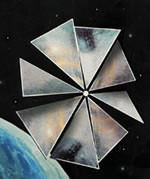
Image credit: Planetary Society
A full-sized replica of a Cosmos 1 solar sail is now on display at the Rockefeller Center “Centennial of Flight” exhibit in New York City. The 14.3 metre blade is made of a silvery Mylar-like material and joins several other exhibits at the show. If all goes well, the real solar sail will be launched on board a refurbished Russian ICBM some time this fall. The sail will be on display until August 18, 2003.
Planetary Society and Cosmos Studios will unfold a replica of one of the eight 47-foot blades that make up the Cosmos 1 Solar Sail spacecraft, which is slated to launch later this year. The silvery mylar-like blade will be on display in New York City as part of a large Rockefeller Center “Centennial of Flight” exhibit. The exhibit is from July 29 – August 18. Suspended from the soaring lobby ceiling, the blade will give the public their first-ever opportunity to see a technology that will likely fly missions throughout the solar system and to the stars.
A joint venture of The Planetary Society and Cosmos Studios, the Cosmos 1 Solar Sail is a visionary approach to space exploration. This is the first space mission ever conducted by a space interest group, and also the first by an entertainment media company.
“During the early 20th Century humanity found its wings above the sands of Kitty Hawk. Cosmos 1 represents the next centennial of flight, which will take us and our robotic emissaries from Earth to Mars, Pluto and beyond,” said Dr. Louis Friedman, Cosmos 1 Project Director and Executive Director of The Planetary Society.
“That a century after the Wright Bros.’ first flight, it is still possible for a small group of people with modest means to reach for the stars, is a good sign that the American dream remains vibrant,” said Ann Druyan, Cosmos 1 Program Director and CEO of Cosmos Studios. “Our launch vehicle, a Russian ICBM, has been converted from a weapon of mass destruction into a means of advancing the dream of exploring the universe. In this way, we hope to honor the inspiration of Carl Sagan and to give our kids a critically needed vision of a hopeful future.”
Solar sailing utilizes reflected light pressure pushing on giant panels, which adjust to the continuously changing orbital energy and spacecraft velocity. The sunlight pressure is powerful enough to push spacecraft between the planets. Beyond the solar system, space sailing can be done using powerful lasers focused over long distances in space. Solar sails might help us realize the long-sought dream of interstellar flight.
Other exhibits at the Centennial of Flight Anniversary will include a full-scale model of the Redstone Mercury rocket, a replica of Apollo 13, a model of the Wright Flyer, an X-43C (NASA’s prototype of the SCRAM JET engine), among other exhibits.
Cosmos 1 Solar Sail is a privately funded project with scientific and commercial applications that involve the cooperation of Russian space and defense organizations through a contract with The Planetary Society. The sail blade model being exhibited in part was developed by the Babakin Space Center near Moscow, Russia.
Babakin Space Center is the prime contractor for Cosmos 1. Babakin is a spin-off organization of NPO Lavochkin, one of the largest manufacturers of robotic spacecraft in the world. The Space Research Institute of the Russian Academy of Sciences and Makeev Rocket Design Bureau also play major roles in project development. Makeev is responsible for development of the Volna rocket – which will launch Cosmos 1 – and has made arrangements with the Russian Navy for the launch.
Original Source: Planetary Society News Release
Palomar Begins a New Sky Survey
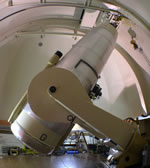
Image credit: Caltech
The Palomar Observatory has begun a new survey of the sky, and will explore the Universe from our solar system out to distant quasars, 10 billion light-years away. The survey will be done with the refurbished 48-inch Oschin telescope with a newly attached digital CCD camera – the largest ever built with 112 separate detectors. The researchers plan to publish images gathered by the telescope onto the web so that other astronomers can search the data for near-earth asteroids, Kuiper Belt objects, supernovae and other objects.
A major new sky survey has begun at the Palomar Observatory. The Palomar-QUEST survey, a collaborative venture between the California Institute of Technology, Yale University, the Jet Propulsion Laboratory, and Indiana University, will explore the universe from our solar system out to the most distant quasars, more than 10 billion light-years away.
The survey will be done using the newly refurbished 48-inch Oschin Telescope, originally used to produce major photographic sky atlases starting in 1950s. At its new technological heart is a very special, fully digital camera. The camera contains 112 digital imaging detectors, known as charge-coupled devices (CCDs). The largest astronomical camera until now has had 30 CCDs. CCDs are often used for digital imaging ranging from common snapshot cameras to sophisticated scientific instruments. Designed and built by scientists at Yale and Indiana Universities, the QUEST (Quasar Equatorial Survey Team) camera was recently installed on the Oschin Telescope. “We are excited by the new data we are starting to obtain from the Palomar Observatory with the new QUEST camera,” says Charles Baltay, Higgins Professor of Physics and Astronomy at Yale University. Baltay’s dream of building a large electronic camera that could capture the entire field of view of a wide-field telescope is now a reality. The survey will generate astronomical data at an unprecedented rate, about one terabyte per month; a terabyte is a million megabytes, an amount of information approximately equivalent to that contained in two million books. In two years, the survey will generate an amount of information about equal to that in the entire Library of Congress.
A major new feature of the Palomar-QUEST survey will be many repeated observations of the same portions of the sky, enabling researchers to find not only objects that move (like asteroids or comets), but also objects that vary in brightness, such as the supernova explosions, variable stars, quasars, or cosmic gamma-ray bursts–and to do this at an unprecedented scale.
“Previous sky surveys provided essentially digital snapshots of the sky”, says S. George Djorgovski, professor of astronomy at Caltech. “Now we are starting to make digital movies of the universe.” Djorgovski and his team, in collaboration with the Yale group, are also planning to use the survey to discover large numbers of very distant quasars–highly luminous objects believed to be powered by massive black holes in the centers of young galaxies–and to use them to probe the early stages of the universe.
Richard Ellis, Steele Professor of Astronomy and director of the Caltech Optical Observatories, will use QUEST in the search for exploding stars, known as supernovae. He and his team, in conjunction with the group from Yale, will use their observations of these exploding stars in an attempt to confirm or deny the recent finding that our universe is accelerating as it expands.
Shri Kulkarni, MacArthur Professor of Astronomy and Planetary Science at Caltech, studies gamma-ray bursts, the most energetic stellar explosions in the cosmos. They are short lived and unpredictable. When a gamma-ray burst is detected its exact location in the sky is uncertain. The automated Oschin Telescope, armed with the QUEST camera’s wide field of view, is poised and ready to pin down the exact location of these explosions, allowing astronomers to catch and study the fading glows of the gamma-ray bursts as they occur.
Closer to home, Caltech associate professor of planetary astronomy Mike Brown is looking for objects at the edge of our solar system, in the icy swarm known as the Kuiper Belt. Brown is convinced that there big objects out there, possibly as big as the planet Mars. He, in collaboration with astronomer David Rabinowitz of Yale, will use QUEST to look for them.
Steve Pravdo, project manager for the Jet Propulsion Laboratory’s Near-Earth Asteroid Tracking (NEAT) Project, will use QUEST to continue the NEAT search which began in 2001. The QUEST camera will extend the search for asteroids that might one day approach or even collide with our planet.
The Palomar-QUEST survey will undoubtedly enable many other kinds of scientific investigations in the years to come. The intent is to make all of the copious amounts of data publicly available in due time on the Web, as a part of the nascent National Virtual Observatory. Roy Williams, member of the professional staff of Caltech’s Center for Advanced Computing Research, is working on the National Virtual Observatory project, which will greatly increase the scientific impact of the data and ease its use for public and educational outreach as well.
The QUEST team members from Indiana University are Jim Musser, Stu Mufson, Kent Honeycutt, Mark Gebhard, and Brice Adams. Yale University’s team includes Charles Baltay, David Rabinowitz, Jeff Snyder, Nick Morgan, Nan Ellman, William Emmet, and Thomas Hurteau. The members from the California Institute of Technology are S. George Djorgovski, Richard Ellis, Ashish Mahabal, and Roy Williams. The Near-Earth Asteroid Tracking team from the Jet Propulsion Laboratory consists of Raymond Bambery, principal investigator, and coinvestigators Michael Hicks, Kenneth Lawrence, Daniel MacDonald, and Steven Pravdo.
Installation of the QUEST camera at the Palomar Observatory was overseen by Robert Brucato, Robert Thicksten, and Hal Petrie.
Original Source: Caltech News Release
Ion Engine Shut Down After Almost Five Years
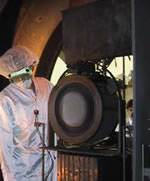
Image credit: NASA/JPL
NASA researchers finally shut down an ion engine that had been running continuously for 30,352 hours. The engine was a duplicate of the one that flew on Deep Space 1, NASA’s mission to test out a range of experimental technologies, and was originally designed to work for 8,000 hours. The engine was finally turned off so that engineers could take it apart to examine the different engine components for wear. Deep Space 1’s engine operated for 16,265 hours.
The future is here for spacecraft propulsion and the trouble-free engine performance that every vehicle operator would like, achieved by an ion engine running for a record 30,352 hours at NASA?s Jet Propulsion Laboratory, Pasadena, Calif.
The engine is a spare of the Deep Space 1 ion engine used during a successful technology demonstration mission that featured a bonus visit to comet Borrelly. It had a design life of 8,000 hours, but researchers kept it running for almost five years, from Oct. 5, 1998, to June 26, 2003, in a rare opportunity to fully observe its performance and wear at different power levels throughout the test. This information is vital to future missions that will use ion propulsion, as well as to current research efforts to develop improved ion thrusters.
“Finding new means to explore our solar system ? rapidly, safely and with the highest possible return on investment ? is a key NASA mission,” said Colleen Hartman, head of Solar System Exploration at NASA Headquarters, Washington, D.C. “Robust in-space flight technologies such as ion propulsion are critical to this effort and will pioneer a new generation of discovery among our neighboring worlds.”
While the engine had not yet reached the end of its life, the decision was made to terminate the test because near-term NASA missions using ion propulsion needed analysis data that required inspection of the different engine components. In particular, the inspection of the thruster?s discharge chamber, where xenon gas is ionized, is critical for mission designers of the upcoming Dawn mission. Dawn, part of NASA’s Discovery Program, will be launched in 2006 to orbit Vesta and Ceres, two of the largest asteroids in the solar system.
“The chamber was in good condition,” said John Brophy, JPL?s project element manager for the Dawn ion propulsion system. “Most of the components showed wear, but nothing that would have caused near-term failure.”
Marc Rayman, former Deep Space 1 project manager, said, ?There are many exciting missions into the solar system that would be unaffordable or truly impossible without ion propulsion. This remarkable test shows that the thrusters have the staying power for long duration missions.?
Ion engines use xenon, the same gas used in photo flash tubes, plasma televisions and some automobile headlights. Deep Space 1 featured the first use of an ion engine as the primary method of propulsion on a NASA spacecraft. That engine was operated for 16,265 hours, the record for operating any propulsion system in space. Ion propulsion systems can be very lightweight, since they can run on just a few grams of xenon gas a day. While the thrust exerted by the engine is quite gentle, its fuel efficiency can reduce trip times and lower launch vehicle costs. This makes it an attractive propulsion system choice for future deep space missions.
“The engine remained under vacuum for the entire test, setting a new record in ion engine endurance testing, a true testament to the tremendous effort and skill of the entire team,” said Anita Sengupta, staff engineer in JPL?s Advanced Propulsion Technology Group. “This unique scientific opportunity benefits current and potential programs.”
“The dedicated work of NASA?s Solar Electric Technology Application Readiness test team, led by JPL, continues to exemplify a commitment to engineering excellence,” said Les Johnson, who leads the In-Space Propulsion Program at NASA?s Marshall Space Flight Center, Huntsville, Ala. “This work, along with significant contributions from NASA?s Glenn Research Center in Cleveland, will take NASA?s space exploration to the next level.”
NASA?s next-generation ion propulsion efforts are led by the In-Space Propulsion Program, managed by the Office of Space Science at NASA Headquarters and implemented by the Marshall Center. The program seeks to develop advanced propulsion technologies that will help near and mid-term NASA science missions by significantly reducing cost, mass or travel times.
Original Source: NASA/JPL News Release
Leaders Renew Space Station Commitment
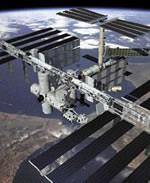
Image credit: NASA
Leaders from five of the world’s space agencies met in California this week and pledged to continue building the International Space Station, despite the delays and setbacks from the Columbia disaster. The five groups represented the US, Canada, Europe, Japan and Russia and they usually meet twice a year. Their next meeting is scheduled for October in Moscow to discuss the impact the Columbia accident investigation report will have on their plans.
Space agency leaders from the United States, Europe, Canada, Japan and Russia met today in Monterey California, to review the status of cooperation on the International Space Station (ISS) Program.
The meeting participants noted the significant milestone of the 1,000th day of permanent human presence aboard the ISS in a live telephone conversation with Expedition Seven Commander, Yuri Malenchenko, and NASA ISS Science Officer, Ed Lu, the cosmonaut and astronaut members of Expedition Seven. The Heads of Agency were briefed on the preliminary recommendations of the Columbia Accident Investigation Board and NASA’s plans for the return to flight of the U.S. Space Shuttle. They agreed to review and update the ISS Program Action Plan, adopted in December 2002, in order to realize the objectives of the ISS Program as soon as possible. The HOA agreed that the ISS Program Action Plan should remain the basis for proceeding with selection of an ISS configuration. The HOA also agreed to meet again in Moscow in mid-October to discuss specific ISS implementation plans taking into account NASA’s Return to Flight activities.
Appreciation was expressed for the strong support for the ISS Program by all Partner agencies, and in particular by the Russian Aviation and Space Agency, for resolutely providing for continuing human presence on the ISS after the tragic loss of the Space Shuttle Columbia and her courageous crew. The ISS partnership looks forward to continuing critical Russian support for general ISS operations, logistics and crew transportation and rescue capability until the Space Shuttle returns to flight and beyond. The Partners expressed great enthusiasm for NASA’s Return to Flight and the timely resumption of ISS assembly and opportunities for enhanced utilization of this world-class research facility.
Original Source: NASA News Release
NASA Needs Better Shuttle Pictures
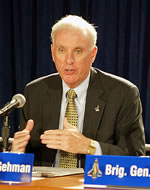
Image credit: CAIB
The Columbia Accident Investigation Board released its fifth major finding today, which recommends that NASA improve the way it takes photographs of the shuttle launch. During the launch of Columbia, NASA cameras provided poor images from a critical point of view which would have showed foam falling from the external fuel tank more clearly. NASA is considering additional ground, aircraft, and even shuttle-mounted cameras to better document future launches. The final report is expected within a month.
The Columbia Accident Investigation Board today issued its fifth preliminary finding and recommendation to the National Aeronautics and Space Administration, in advance of its appearance in the final report.
Recommendation Five:
- Provide a capability to obtain and downlink high-resolution images of the External Tank (ET) after ET separation. Modifying one of the two umbilical cameras to meet this requirement is acceptable.
- Provide a capability to obtain and downlink high-resolution images of the underside of the orbiter leading edge system and forward section of both wings? Thermal Protection System (TPS).
Facts:
- Imaging the Space Shuttle System during launch and ascent provides necessary engineering data including the ability to examine the Space Shuttle System for any unexpected debris or other anomalies during ascent.
- The Shuttle has two on-board cameras that image the ET after separation, but the images from these cameras are available only post-flight.
- Very little engineering quality, on-board imaging of the ET was available for STS-107.
Findings:
- There is a requirement to obtain and downlink on-board engineering quality imaging from the vehicle during launch and ascent.
Background:
- The Space Shuttle is still a developmental vehicle, and engineering data from each launch is essential to further understand the vehicle.
- An ability to provide engineering quality imaging data of the ET after separation is important to determine if any debris from the ET was shed during ascent.
- Since the total elimination of all sources of debris has not yet been achieved, a much better understanding of all the potential sources of debris is required.
- Since the total elimination of all sources of debris has not yet been achieved, early detection of debris strikes against the forward underwing TPS of both wings will increase safety margins.
- The CAIB is aware of the excellent preliminary work already in progress at NASA in this area.
Original Source: CAIB News Release
Neutron Star Binaries are More Common in Clusters
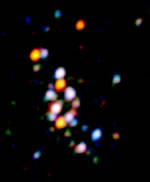
Image credit: Chandra
Many of the stars that we see in globular star clusters are actually binary stars, formed when two stars get caught in each other’s gravity. But new research from the Chandra X-Ray Observatory shows that there are many more binary objects which are stars orbiting a neutron star or white dwarf. Chandra can detect the unique x-ray signature that a neutron star gives off, which is invisible in an optical telescope. The research seems to indicate that these neutron star binaries form much more commonly found in globular clusters than in other parts of a galaxy.
NASA’s Chandra X-ray Observatory has confirmed that close encounters between stars form X-ray emitting, double-star systems in dense globular star clusters. These X-ray binaries have a different birth process than their cousins outside globular clusters, and should have a profound influence on the cluster’s evolution.
A team of scientists led by David Pooley of the Massachusetts Institute of Technology in Cambridge took advantage of Chandra’s unique ability to precisely locate and resolve individual sources to determine the number of X-ray sources in 12 globular clusters in our Galaxy. Most of the sources are binary systems containing a collapsed star such as a neutron star or a white dwarf star that is pulling matter off a normal, Sun-like companion star.
“We found that the number of X-ray binaries is closely correlated with the rate of encounters between stars in the clusters,” said Pooley. “Our conclusion is that the binaries are formed as a consequence of these encounters. It is a case of nurture not nature.”
A similar study led by Craig Heinke of the Harvard-Smithsonian Center for Astrophysics in Cambridge, Mass. confirmed this conclusion, and showed that roughly 10 percent of these X-ray binary systems contain neutron stars. Most of these neutron stars are usually quiet, spending less than 10% of their time actively feeding from their companion.
A globular cluster is a spherical collection of hundreds of thousands or even millions of stars buzzing around each other in a gravitationally-bound stellar beehive that is about a hundred light years in diameter. The stars in a globular cluster are often only about a tenth of a light year apart. For comparison, the nearest star to the Sun, Proxima Centauri, is 4.2 light years away.
With so many stars moving so close together, interactions between stars occur frequently in globular clusters. The stars, while rarely colliding, do get close enough to form binary star systems or cause binary stars to exchange partners in intricate dances. The data suggest that X-ray binary systems are formed in dense clusters known as globular clusters about once a day somewhere in the universe.
Observations by NASA’s Uhuru X-ray satellite in the 1970’s showed that globular clusters seemed to contain a disproportionately large number of X-ray binary sources compared to the Galaxy as a whole. Normally only one in a billion stars is a member of an X-ray binary system containing a neutron star, whereas in globular clusters, the fraction is more like one in a million.
The present research confirms earlier suggestions that the chance of forming an X-ray binary system is dramatically increased by the congestion in a globular cluster. Under these conditions two processes, known as three-star exchange collisions, and tidal captures, can lead to a thousandfold increase in the number of X-ray sources in globular clusters.
In an exchange collision, a lone neutron star encounters a pair of ordinary stars. The intense gravity of the neutron star can induce the most massive ordinary star to “change partners,” and pair up with the neutron star while ejecting the lighter star.
A neutron star could also make a grazing collision with a single normal star, and the intense gravity of the neutron star could distort the gravity of the normal star in the process. The energy lost in the distortion, could prevent the normal star from escaping from the neutron star, leading to what is called tidal capture.
“In addition to solving a long-standing mystery, Chandra data offer an opportunity for a deeper understanding of globular cluster evolution,” said Heinke. “For example, the energy released in the formation of close binary systems could keep the central parts of the cluster from collapsing to form a massive black hole.”
NASA’s Marshall Space Flight Center, Huntsville, Ala., manages the Chandra program for the Office of Space Science, NASA Headquarters, Washington. Northrop Grumman of Redondo Beach, Calif., formerly TRW, Inc., was the prime development contractor for the observatory. The Smithsonian Astrophysical Observatory controls science and flight operations from the Chandra X-ray Center in Cambridge, Mass.
Original Source: Chandra News Release
Ion Drive Powered Spacecraft
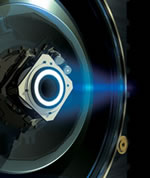
Image credit: ESA
The European Space Agency’s SMART-1 mission will use a revolutionary ion engine to help it search for evidence that the Moon was formed after a violent collision of a smaller planet with the Earth. An ion engine works by accelerating ionized particles of gas in a constant stream for months or even years. Although the thrust is very low, it’s very efficient and requires a fraction of fuel that traditional rockets use.
Science fiction movie fans know that, if you want to travel short distances from your home planet, you would use a sublight ‘ion drive’. However, is such an ion drive science fiction, or science fact?
The answer lies somewhere in between. Ion engines date back to at least 1959. Two ion engines were even tested in 1964 on the American SERT 1 satellite – one was successful, the other was not.
The principle is simply conventional physics – you take a gas and you ionise it, which means that you give it an electrical charge. This creates positively charged ions of gas, along with electrons. The ionised gas passes through an electric field or screen at the back of the engine and the ions leave the engine, producing a thrust in the opposite direction.
Very fuel-efficient
Operating in the near vacuum of space, ion engines shoot out the propellant gas much faster than the jet of a chemical rocket. They therefore deliver about ten times as much thrust per kilogram of propellant used, making them very ‘fuel-efficient’.
Although they are efficient, ion engines are very low-thrust devices. The amount of push you get for the amount of propellant used is very good, but they do not push very strongly. For example, astronauts could never use them for taking off the surface of a planet. However, once in space, they could use them for manoeuvring around, if they are not in a hurry to accelerate quickly. Why? Ion drives can get up to high speeds in space, but they need a very long distance to build up to such speeds over time.
Leisurely advantage
Ion engines work their magic in a leisurely way. Electric guns accelerate the ions. If the power for this acceleration comes from the spacecraft’s solar panels, scientists call it ‘solar-electric propulsion’. Solar panels of the size typically used on current spacecraft can supply only a few kilowatts of power.
A solar-powered ion engine could therefore not compete with the large thrust of a chemical rocket. However, a typical chemical rocket burns for only a few minutes, whereas an ion engine can go on pushing gently for months or even years – as long as the Sun shines and the supply of propellant lasts.
Another advantage of gentle thrust is that it allows very accurate spacecraft control, very useful for scientific missions that require highly precise target pointing.
Ensuring ESA’s place in space
Engineers tested an ion engine as a main propulsion system for the first time using NASA’s Deep Space 1 mission between 1998 and 2001. ESA’s SMART-1 mission, due for launch in late August 2003, will go to the Moon and demonstrate more subtle operations of the kind needed in future long-distance missions. These will combine solar-electric propulsion with manoeuvres using the gravity of planets and moons for the first time.
SMART-1 will ensure Europe’s independence in the use of ion propulsion. Other space science missions are expected to use ion engines for complex manoeuvres close to Earth’s orbit. For example, ESA’s mission LISA will detect gravitational waves coming from the distant Universe. ESA’s future missions to the planets will also use ion engines to send them on their way.
Now science fact
The present-day realities of solar-electric propulsion might not match the movie magic of sci-fi films with spacecraft flying around on our cinema screens. However, ESA’s work on SMART-1 and future missions is ensuring that ion drives are now more science fact than science fiction.
Original Source: ESA News Release
